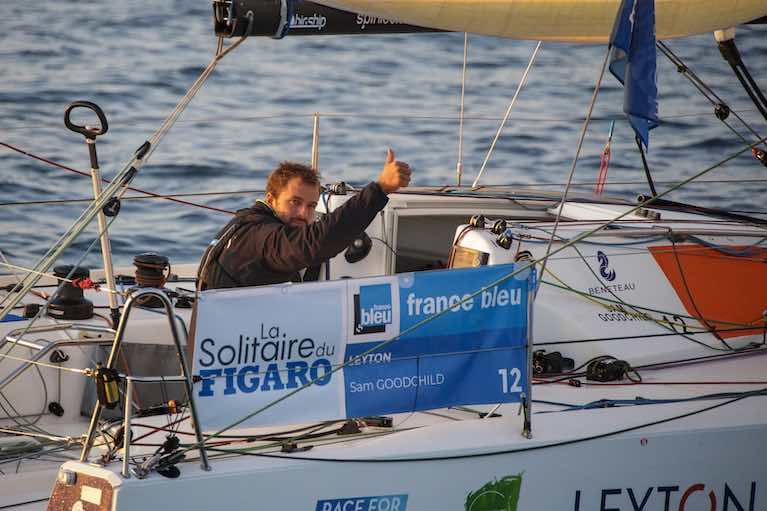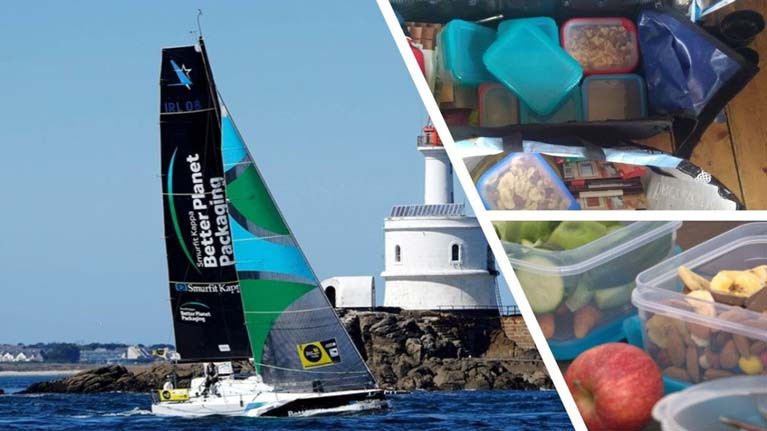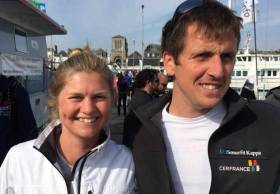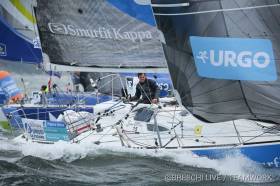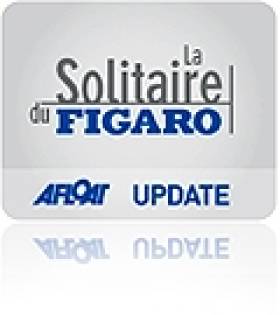Displaying items by tag: Solitaire du Figaro
Ireland's Solitaire du Figaro Sailor Tom Dolan Sees Multiple Challenges, Multiple Fronts Caen – Kinsale Leg
After a week in Caen, Normandy, the 32 competitors competing in the 54th edition of La Solitaire du Figaro Paprec will head out to the English Channel on Sunday to make ready for a challenging first leg to Kinsale, Ireland. This first of three legs starts off Ouistreham at 1302hrs local time.
Caen – Kinsale
The first stage of this Solitaire du Figaro Paprec 2023 starts from the Côte deNacre, crosses the English Channel three times before rounding the Fastnet Rock and heading into the beautiful Irish haven of Kinsale.
“This will be a very varied, challenging stage with lots of twists and turns.” Says Yann Chateau, race director who has drawn a course that mixes coastal passages before a more open, offshore passage across the Celtic Sea to Ireland.
As they start this 610-mile (1,130 km) long leg the 32 solo opens with a short, inshore preliminary course, for the Trophée Paprec, which is designed to salute the city of Caen, which has hosted the start week.
The stage should begin with a northwesterly wind of 12-15knots as they reach across the Channel to Nab Tower, where they turn west past the Isle of Wight. An occluded front – the first of three - is likely to see the breeze drop away here and make it difficult as they near the Needles Fairway mark. From there they head for the Héaux de Bréhat at the northern tip of Brittany. As tiredness starts to bite, decisions need to be taken how to deal with the currents and the maritime traffic.
“Tuesday, we are expecting the arrival of a depression which will pass in the North of the British Isles during the day of Tuesday. This new system will bring a sustained flow from the South, strengthening up to 25 knots as it turns right to settle in the North-West. But then the scenario becomes more uncertain. The models still diverge a lot on the conditions of this end of the course in the Celtic Sea, around the Ireland of and the Fatsnet that the first should wind between Wednesday evening and early Thursday morning," comments Yann Chateau.
It seems likely then that this will be a course full of opportunities right to the finish.
Ireland's Tom Dolan (Smurfit Kappa-Kingspan) said: “For the past week, I have been trying not to think too much about the finish line of this stage, which takes me home to Ireland. It's a stage just like the others with the weather and the competitors to manage, but I really try not to lose focus by thinking too much about the final result and where we are going. Three occluded fronts will pass over the fleet between here and Ireland. We will race mainly upwind, but we will also have to manage shifts in the wind, especially when we have to negotiate the TSS (traffic separation scheme) of the Scillies. We could see the fleet heading in all different directions. This will certainly be a key moment, just like the Needles, which we risk passing right through the front, then with light winds with a lot of current. And plenty can happen there, just like in West Scilly. Also, when to really aim for the Fastnet, the timing of that move might prove key.
Marcus Hutchinson Elected Figaro Class Vice President as French Circuit Looks To Relaunch
The Figaro Beneteau class held its general assembly on December 9. There the 2022 calendar was adopted and the creation of an Academy was validated. This initiative is intended to facilitate access to the circuit for newcomers. This is seen as a necessity for a class that is seeing the number of participants on the circuit dropping.
With just 34 participants competing, the 2021 edition of La Solitaire du Figaro had the fewest entrants for more than 20 years. This is a downwards trend that contrasts with other offshore classes. "We realise that things are sold out on the Mini Transat and that there are plenty of new projects in Class40, while for us, there seem to be less and less people", recognises Estelle Graveleau, Director of the Team Vendee Formation and member of the class's board of directors.
 Howth's Marcus Hutchinson has just been elected vice-president of the class
Howth's Marcus Hutchinson has just been elected vice-president of the class
Amateurs are now almost non-existent, the class says.
From an Irish perspective, Ireland has had a small but continued interest in the Figaro most recently recording Ireland's top ever result in the race, fifth overall in 2020, thanks to the exploits of France-based Tom Dolan of County Meath.
And after two seasons in France campaigning a Figaro 3 in both double-handed and solo sailing disciplines, it has become apparent to Irish offshore sailor Kenny Rumball that there are no grassroots feeds to the professional offshore racing scene in Ireland. The Dun Laoghaire Harbour sailor intends to rectify this with his new Offshore Racing Academy.
The explanations for the decline are diverse. "Unlike other races which are based on flagship events every two or maybe four years, the Figaro class needs to organize its main race, La Solitaire du Figaro every year. In itself that was a feat last year to run the race but we have suffered more than others from the health crisis, it was very complicated to set up a schedule," Howth native Marcus Hutchinson, who has just been elected vice-president of the class, told Tip and Shaft website.
More on the Figaro Beneteau class efforts to introduce new sailors here on the Tip and Shaft website
Tom Dolan Finishes Tenth in Stage One of Figaro Solo
Localised wind shifts in the finishing sections of Stage 1 of the Figaro Solo 2021 at Lorient this morning saw Tom Dolan in Smurfit Kappa - Kingspan being pipped for ninth place by one minute by female skipper Elodie Bonafous racing Bretagne - CMB Oceane. After being in or around 16th place for much of the first half of the race out to the turning mark off Spain, Dolan revelled in the sometimes rugged windward conditions coming back across the Bay of Biscay towards the Loirent finish, and at one stage he was pacing so well that he was being recorded as lying seventh.
However, with his immediate competitors including the likes of proven performer Alexis Loison, it was all he could do to maintain his placing rather than move even further up the rankings, and some difficult tactical challenges saw Loison slip through to finish sixth, while Dolan’s Transatlantic shipmate Gildas Mahe in Breizh Cola also got away to finish seventh. The battle for 8th was then between Gaston Morvan, Elodie Bonafous and Tom Dolan, and just 1 minute and 20 seconds covered the finish times of the three boats, but it was Tom Dolan who’d drawn the short straw.
Up at the front of the fleet, however, things were rather different with winner Xavier Macaire taking it by 43 minutes clear from Pierre Quiroga in Skipper Macif 2019, with Tom Laperche in CMB Performance 41 minutes further astern in third.
On the dock in Lorient this morning a tired but content Dolan said, “Tenth is a good result. The group of boats behind me split in two and I didn’t know which to cover. One group got past, but apart from that, it was good. I had fairly good boat speed upwind and I chose the right tacks and stuck to the plan and it worked well. It was cool to be alongside Gildas Mahé as we train together. A pity I didn’t catch him, but I’ll get him next time. For me, it was important not to knock myself out on the first leg as that would mean spending your time trying to catch up. Time-wise, I am in touch with everyone, apart from Xavier. Mentally I was good and never cracked even after the bad start. I was pleased with the speed. It was good fun in the waves and gusts of thirty knots and some extreme broaches. There was a full moon, so that was good fun. I had the mast nearly in the water twice. It was not the hardest leg we’ve done. Upwind it was OK. We just had to trim the sails now and again and try to decide where to go.”
 Ireland’s Tom Dolan finished 10th into Lorient this morning concluding the first stage of La Solitaire du Figaro with a result which matches his 10th place in 2020 when he finished fifth overall at the end of the three stages. The skipper of Smurfit Kappa- Kingspan was 17th in the 34 boat fleet when they rounded the La Coruna buoy, the midpoint of the 627 miles course but made good gains with excellent upwind boat speed.
Ireland’s Tom Dolan finished 10th into Lorient this morning concluding the first stage of La Solitaire du Figaro with a result which matches his 10th place in 2020 when he finished fifth overall at the end of the three stages. The skipper of Smurfit Kappa- Kingspan was 17th in the 34 boat fleet when they rounded the La Coruna buoy, the midpoint of the 627 miles course but made good gains with excellent upwind boat speed.
Tracker chart here
Figaro Leader Sam Goodchild Well Placed To Deal With A Night of Calms
Having led the 33 strong La Solitaire du Figaro fleet since the early hours of this morning Britain’s Sam Goodchild (Leyton) has had to see his hard-earned margin evaporate in a fast failing breeze off the Baie de Morlaix this evening. The two Irish sailors in leg three are currently placed 19th (Tom Dolan) and (Kenny Rumball) 30th. Tracker here.
For the 30-year-old Brit solo racer who placed twice on the podium of warm-up Figaro races this season and who, on Sunday, started the 492 miles Stage 3 from Dunkirk in third position overall, seeing the fleet fall in on his stern was not unexpected as the forecasted shut down in the light easterly breeze arrived.
Goodchild has sailed an outstanding leg so far, fast in all conditions, focused and making assured, relatively low-risk moves. But the final 195 nautical miles, around the tip of Brittany, and south to the finish line at Saint Nazaire at the entrance to the Loire look set to be painfully slow. “We are just coming up to the north Brittany coast. Forecast-wise now we only have what we get from MeteoConsult and that leaves some grey areas, they are not very precise. At the moment the idea is to get to coast quickly to be able to hide or anchor if we need from the strong tide.” Reported Goodchild today as he raced side by side with Xavier Macaire (Groupe SNEF) who won Stage 1.
The Leyton skipper added, “I took advantage of my investment to the SW yesterday and managed to round the Cap de la Hague in the lead with Xavier Macaire who was further out to sea. Achilles Nebout went off Alderney and Adrien Hardy sailed off towards Guernsey, but we may all get back together again depending on what happens to the weather. We’re waiting for the next weather forecast to see what is coming up. We’re expecting to come to a stop off Northern Brittany and we’ll see how things get going again. As usual, there is a lot of seaweed. There are a hundred miles to sail now with very little wind. Guernsey looks good from here. I have never been there but we’re sailing close to the rocks and enjoying the view. Conditions have been easy and pleasant so far.”
Sounding relaxed today Sam Goodchild has already shown considerable maturity and serenity so far and worked carefully with Corentin Douguet on a weather strategy, his friend and rival French skipper being forced out of the race with a damaged vertebrae in his back. “Sam really has followed the game plan we developed beforehand to the letter.” Commented Douguet, “ He is sailing very quickly, always making the right decisions, without ever taking any risks and so far the conditions have been to his advantage. Certain options taken by skippers after passing Dieppe surprised me, but it is not in my philosophy to choose extreme routings when conditions are uncertain. We can still see guys like Eric Péron (French Touch) and Adrien Hardy (Ocean Attitude), who like to "bang the corners". The crucial phases went well for Sam, who is having a very good season. But the remainder of the leg seems more complicated. It seems to me that the hardest part is yet to come.”
With Armel Le Cléac’h more than 12 miles, or two hours behind, in 24th today these two sailors would top the General Classification, but this promises to be an exceptionally challenging, slow night as small, localised low pressure systems such away all of the breeze.
Macaire, who took a narrow lead back from Goodchild this evening, a matter of 150 metres of so, said today, “The sun is out, so it is fairly pleasant today. It’s nice to be out at the front of the fleet. We have got away from the pack behind. The wind is going to drop off this evening and during the night. So a lot could happen. The pack could catch up. I don’t know what to expect. It looks like it is going to be a long one. We knew what was going to happen back at the start with several areas of calm ahead of us. We have just been through one on this second day of racing. And there’s a second one late this afternoon or this evening. We’ll have to wait and see what happens. I have a rough idea of what lies ahead, but I can’t say for the moment what my strategy will be. That will depend on how the wind shifts. We may be close to the coast or further off. We’ve certainly got plenty to amuse ourselves with”
The six leading boats were compacted back to within one mile of each other. The favourable ebb current should work with them from 1800hrs this evening to help them pass the entrance to the Baie de Morlaix. This is probably the most familiar stretch of coastline for the Figaro racers but there will certainly be elements of good and bad luck come into play tonight. The tide will help for the first part of the night but by Portsall, on the corner, the strong tides will be against them and anchoring may be required before Ushant.
“These small low pressure systems are lurking around the tip of Brittany ” explained Francis Le Goff, Race Director. "From tonight they will suck up all the wind, pretty much for whole of the night. In the end this leg is going to be around 96 hours of racing," said Race Director Le Goff, holding on to the idea of a finish time in Saint Nazaire on Wednesday afternoon. He has already postponed the start of the final leg.
Among the notable recoveries in the light airs Yann Eliès (Quéguiner Materiaux-Leucémie Espoir) was back up to eighth at three miles behind the leaders and Alan Roberts (Seacat Services) was in 12th 4,3 miles behind his compatriot Goodchild.
Tracker here.
Fancy a little distraction? I've decided to show you some of the steps that we took to reduce waste during last year's Solitaire du Figaro writes Irish Solo Sailor Tom Dolan
Now more than ever we all need to think about what we buy, where it comes from and where it goes afterwards.
Snacks are difficult to choose; they need to be high in calories while at the same time being tough enough to survive banging around the boat for a couple of days.
So, we can quickly get lazy when shopping and buy things that are triple wrapped in single-use plastic, things that we wouldn't normally eat on land. So why do differently at sea? It took a bit of searching.
I found this great chocolate called 'Grain de Sail', which is manufactured in Brittany. The raw materials (green coffee and cocoa) come mainly from the Caribbean and Central America and are sourced equitably. The company are building their own sailing boat in order to transport the raw materials under sail! Their packaging is made entirely of paper and to top it all off it is very, very good!
I bought dried and fresh fruit and stored it in reusable Tupperware boxes along with cold meats and portions of cheese all from the local market or shop and again wrapped in paper.
- Sacrifices: Babybel, Snickers and penguin bars!
- What I saved: A little under one small bin bag full of single-use plastic packaging
- Shopping list: Lots and lots of reusable Tupperware!
Solitaire Du Figaro Returns To Ireland This Summer In 50th Gala Edition
Following last year’s performance of ‘Flying Irishman’ Tom Dolan and pioneering woman Joan Mulloy in their Solitaire du Figaro debuts, now the renowned solo offshore race is coming to Ireland.
The Solitaire URGO Le Figaro is set to return to Kinsale this summer for the first time since 2009 for its 50th gala edition, with a course that takes in a rounding of Fastnet Rock to Kinsale on the weekend of 8-9 June to end its first leg out of Nantes.
The racing fleet continues on a “marathon run” around the Irish coast through the Irish Sea, around the Isle of Man and back down the west coast of Great Britain to Roscoff in northern France.
Stage three is a loop of ‘La Manche’ back to Roscoff before the final stage, via Wolf Rock and the Isle of Wight, to Dieppe. In all the course covers 2,130 miles (not accounting for weather-related changes).
Tom Dolan has already pledged his return for his second Figaro, this time in his new Figaro 3 boat, while the presence of Joan Mulloy — Ireland’s first female entry in the race — will further buoy Irish interest in the challenge as it takes in our coast.
Dolan tells Afloat.ie that he is “itching to get going after three months of computers and meetings!”
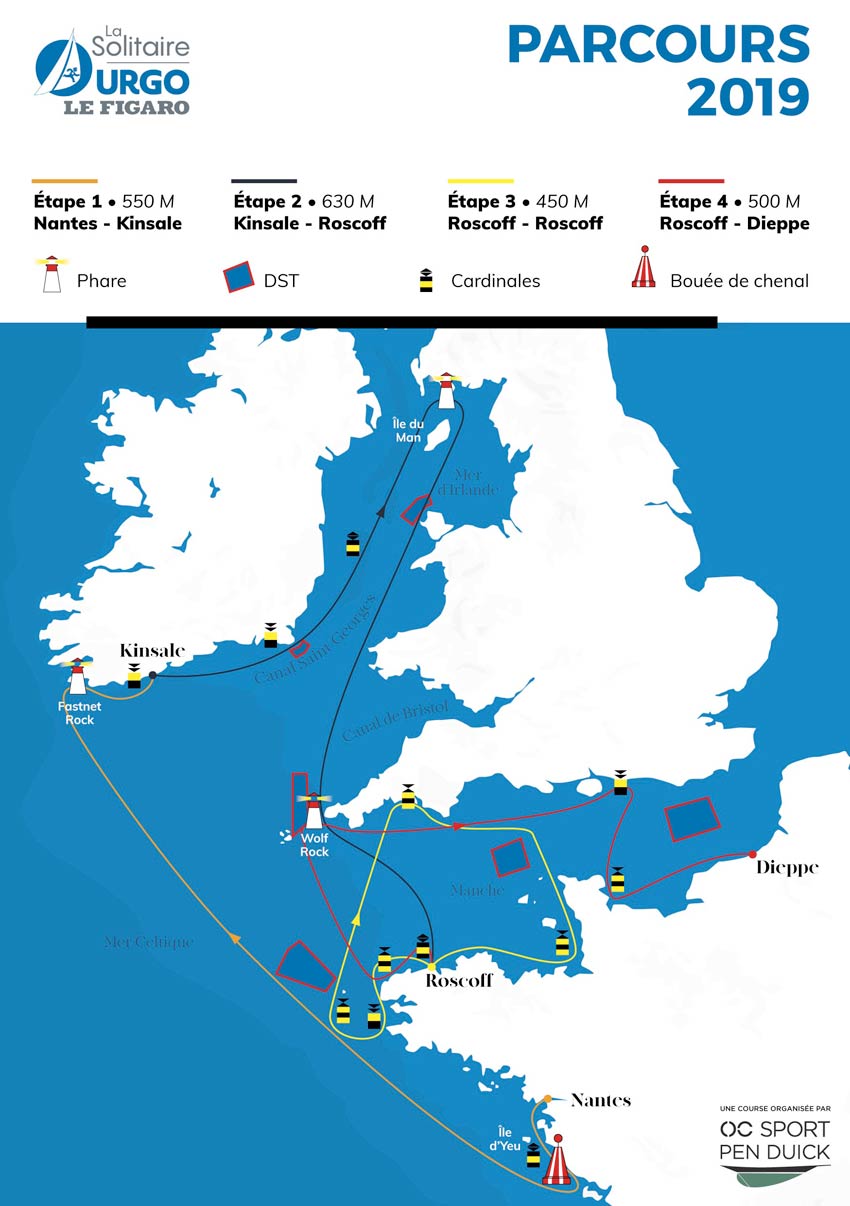
Race organisers add:
The Solitaire URGO Le Figaro is set to enter a new era this year, with the introduction of the new Figaro Bénéteau 3 for the 50th edition of the annual solo sailing race. Starting from the French city of Nantes on June 2nd, 2,130 nautical miles of challenging offshore racing around some of Europe’s roughest waters await the Figaro skippers, including a return to Ireland with a stopover in Kinsale.
Owned and organised by OC Sport’s French subsidiary OC Sport Penduick, the Solitaire URGO Le Figaro is one of the world’s toughest sailing competitions. Fiercely competitive, the race is recognised as the unofficial world championship of solo offshore racing, with the course taking just over a month to complete. Requiring a unique skill set, the Solitaire URGO Le Figaro pushes competitors to the edges of their physical and mental limits.
OC Sport Pen Duick Event Director Mathieu Sarrot commented: “This anniversary year of the Solitaire is set to be an historic edition and we are expecting a diverse fleet including previous winners and new comers to the new Figaro Bénéteau 3. This means the stakes will be high with everyone out to prove themselves in a new boat.
“On the water it will be particularly challenging,” Sarrot continued. “To be successful the competitors will need seasoned offshore experience as well as coastal knowledge. But also sheer grit and determination. With the ongoing support of our title partner URGO, it’s set to be an incredible 50th edition."
The fleet will start leg 1 under the striking bridge of Saint-Nazaire following a passage through the river Loire from the historic city of Nantes in Brittany. After rounding Île d’ Yeu, they will head across the Celtic Sea before passing the legendary Fastnet Rock and heading to the port of Kinsale, Ireland. At 500 nautical miles, the fleet will be immersed in a tough race from the off with a drag race through potentially choppy seas to keep the solo skippers on their toes before they arrive in Irish waters.
Speaking on behalf of the Kinsale Chamber of Tourism and Business, Board Member Ciaran Fitzgerald and Chairperson Guny Patel commented: “Kinsale Chamber is delighted with the announcement that the 50th Anniversary of the prestigious La Solitaire Le Figaro yacht race has been awarded to Kinsale for June 2019.
“This is an amazing event for Kinsale to host and welcome back having hosted this world famous single handed race more than any Port over the 50 years of the race. Kinsale Chamber looks forward to welcoming the sailors and visitors for what will be an incredible spectacle on sea and land over the five days of the stopover. Congratulation to Enda O'Coineen and his team for bringing this event to Ireland.”
Expected to arrive in Kinsale on Wednesday 5th June, the Solitaire URGO Le Figaro fleet will stay in Ireland until Sunday 9th June, when the skippers will set sail on the longest 630-nautical mile Leg 2 to Roscoff in northern Brittany. In a first for the Figaro fleet, this marathon stage will take the skippers along the stunning Irish coast and through the unpredictable, and at times dangerous, Irish sea before rounding the Isle of Man. A long descent along the rugged western Welsh coast, followed by a passage between Land's End and the Scilly Isles, before a crossing of the English Channel towards Roscoff will conclude what is sure to be a gruelling leg.
From Roscoff, the fleet will stay in the familiar waters of Brittany where they will tackle a 450 nautical mile coastal course that will require them to use all of their technical and tactical prowess in the strong tidal currents, before returning to Roscoff on Wednesday 19th June.
To end the 2019 Solitaire URGO Le Figaro, the increasingly exhausted fleet have a double Channel crossing to contend with. At 500 nautical miles, the final leg will see the competitors leave Roscoff on Saturday 22nd June to head across the channel towards Land’s End via a starboard rounding of the south cardinal navigation mark off Portsall. From there, they will have to negotiate the difficult conditions along the south coast of England before skirting the Isle of Wight, and crossing back into French waters through one of the world’s busiest shipping lanes. With fast depleting energy, the skippers will need to keep their wits about them as they head to a mark off Barfleur, before the final sprint into the Normandy fishing port of Dieppe.
The skippers are expected to arrive in Dieppe on Wednesday 26th June, with a non-points scoring postlogue race planned for Saturday 29th June allowing the public to see the new Figaro Bénéteau 3’s in action before the official prize giving where the winner of the 2019 Solitaire URGO Le Figaro will be crowned.
As many as 40 Figaro skippers are expected to compete in this 50th anniversary edition, including former winners alongside a plethora of young talent. At 2,130 nm, the 2019 Solitaire URGO Le Figaro course is one of the longest in race history and it will take everything in the skippers’ solo offshore arsenal to get them to the finish line.
With just over five months to go until the build-up begins in Nantes, the skippers will be using this valuable time to take delivery and train on their new Figaro Bénéteau 3’s. A full skippers line-up will be revealed in April.
La Solitaire URGO Le Figaro 2019 Schedule
May 27th: Arrival of the fleet in Nantes, France
June 2nd, Leg 1 start: Nantes, France – Kinsale, Ireland (via Fastnet Rock) – 500nm
June 9th, Leg 2 start: Kinsale, Ireland – Roscoff, France (via the Isle of Man) – 360nm
June 16th, Leg 3 start: Roscoff, France – Roscoff, France - 450nm
June 22nd, Leg 4 start: Roscoff, France – Dieppe, France – 460nm
June 26th: Anticipated arrival of first boats in Dieppe
June 29th: Postlogue and awards ceremony in Dieppe
Lecture: Sailing in the Fast Lane - What’s Next?
#lectures- An illustrated lecture Sailing in the Fast Lane- What’s Next? by Tom Dolan is to be held next week, Thursday 10 January (20:00) at Poolbeg Yacht & Boat Club Ringsend, Dublin.
Admission fee of €5 (in aid of Sailing into Wellness).
Tom Dolan’s intense 2018 season, competing over an 8,000 miles racing circuit, culminated in the Solitaire du Figaro. This racing competition is widely considered as the highest level there is in singlehanded offshore sailing. Despite being his first Figaro season, Tom was on the podium in December at the Paris International Boat Show for his third place award in the Rookie sector.
Tom Dolan is here to tell us how it went, warts and all, and illustrating it with his revealing videos.
2018 had it all: Strong winds, intense moments, big waves and big upsets. He will also reveal his plan for the Solitaire du Figaro 2019 with his new boat, the revolutionary Beneteau Figaro 3, and his longer term dreams. These include racing round the world and representing Ireland in the 2024 Olympics.
Tom’s success as a solo competitive sailor hasn’t blinded him to his Glenans training based on a love of the sea and the power of teamwork on a sailing boat to bring about the best in everybody. Hence his desire to support the work of Sailing into Wellness. Its co-founders, Colin Healy and James Lyons, will speak before Tom about how their sailing programme helps people in their recovery from poor mental health and addiction.
Colin Healy is an expert by experience. During his personal battle with addiction and depression, he found sailing to have a substantial therapeutic value. James Lyons is one of Ireland’s most experienced sail training professionals.
Cammas Could Be Back On Board Next Month After Nearly Losing Foot
#FranckCammas - French America's Cup skipper Franck Cammas could be returning to the water as soon as next month after nearing losing his foot in a boating accident late last year.
As previously reported on Afloat.ie, Team France's top man had his right foot "partially severed" when he was run over by the rudder of his foiling catamaran during training in Brittany in late November.
However, after successful surgery Cammas was assured he would not lose the use of his foot as the arteries and nerves were unaffected.
And according to Bermuda's Royal Gazette, the Solitaire veteran and Volvo Ocean Race winner is making significant progress in rehab for his injury.
“Now I can spend more time onshore working with the designers and engineers on the new boat,” he said after having his cast removed last week.
It's thought that Cammas could be back on board in time for the resumption of the America's Cup World Series in Oman on 27-28 February.
The Royal Gazette has more on the story HERE.
David Kenefick Relaxed & Ready for the Sail of his Life
#fullirsh – David Kenefick's bid for Figaro success as a rookie is underway in Paluillac, France this afternoon after month's of preparation brought the solo Irish sailor to the start line at noon today.
This morning shore teams gave the final touches to the boats and checking each and every detail on board. Earlier the skippers attended the usual pre-start weather briefing led by Météo Consult expert Cyrille Duchesne and gathered for the traditional group photo shooting.
Photos from yesterday's prologue race in the heart of Bordeaux show a relaxed David Kenefick at the helm of Full Irish, organised and focused above all the Cork sailor is now relieved just to be getting on with the job.
The original plan yesterday was to have all 41 boats race about 3 miles up the narrow river but due to a flood up the river several miles away, a dam was needed to be opened which caused a load of trees and some were over 30 feet long to flow down the river. It was to risky to send all the skippers out to race as they could hit a large log and do some damage.
So at 2pm the organisers made a decision to allow the skippers to take as many crew as they wanted to safely sail the race. It was not a race thought but a spectacle for the 25/30k people who lined the 2.3mile shore line on both sides of the river. They staggered the starts in boats of 4, until all 41 boats sailed up the river to the finish.
David's Dad Neil is in France and (pictured below) sailed the race yesterday with David yesterday.
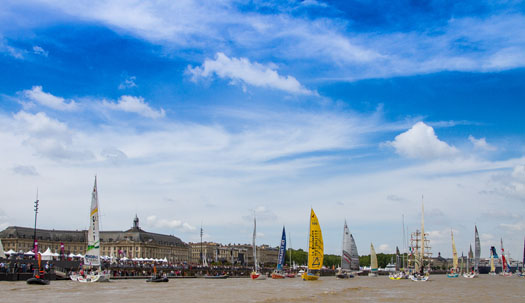
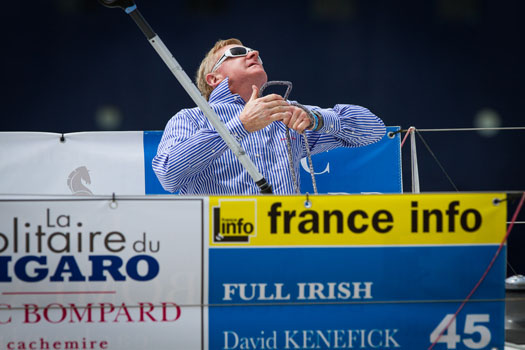
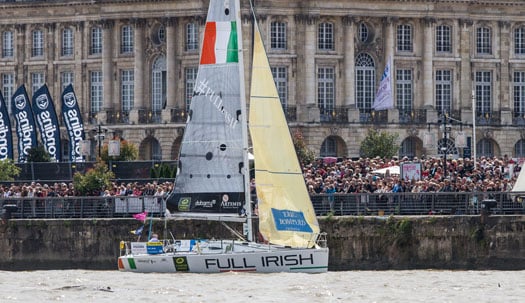
Naval School-Ships to take Class to Dublin
#NAVAL VISITS - The first foreign naval visitors to Dublin Port in 2012 will be the French Navy, as five of an eight-strong class of school-training ships from Brest are due to dock on Friday, writes Jehan Ashmore.
The octet belong to the Léopard class though the namesake leadship, Léopard (A 748) and Jaguar (A 750) will not be forming as part of the visiting flotilla.
Those that will be making the weekend port of call, berthing at Sir John Rogersons Quay will be Panthère (A 749) and Lynx (A 751) both commissioned in 1982 and the remaining quartet Guépard (A 752); Chacal (A 753); Tigre (A 754) and Lion (A 755) which entered service the following year. For a photo of the latter vessel and one of her sisters the Chacal click HERE.
Each of the 44 tonnes vessel's measure 17.5m long and have a beam of 6.40m and drawing a draft of 2.40m. To read more on the class characteristics click HERE.
The class follow in the wake of the last French Naval vessel to enter Dublin Bay, PSP Cormoran (P677). The OPV provided guard-ship duties when accompanying the Solitaire du Figaro race fleet during the stopover to Dun Laoghaire Harbour last August, as previously reported on Afloat.ie


























